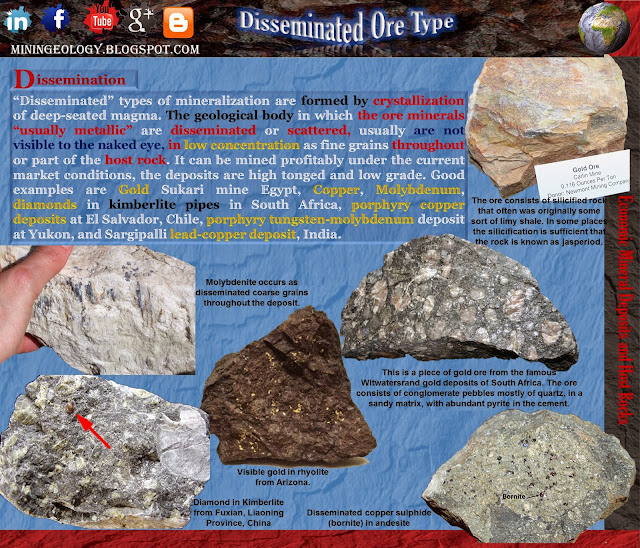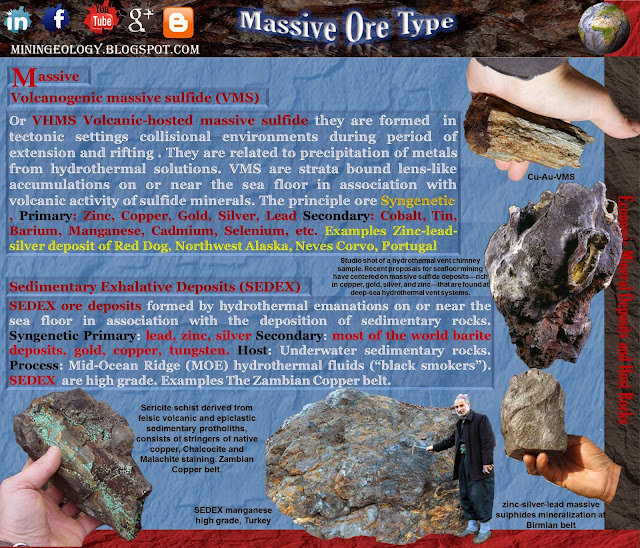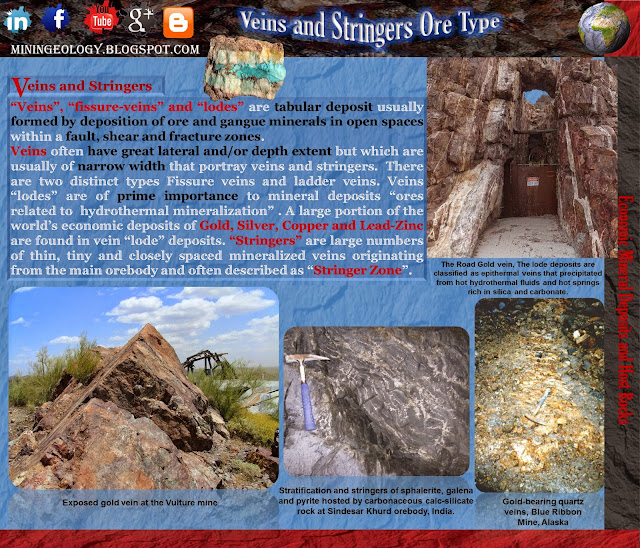Dissemination
Massive
Veins and Stringers
Stock-work
“Disseminated” types of mineralization are formed by crystallization of deep-seated magma. The geological body in which the ore minerals “usually metallic” are disseminated or scattered, usually are not visible to the naked eye, in low concentration as fine grains throughout or part of the host rock. It can be mined profitably under the current market conditions, the deposits are high tonged and low grade. Good examples are Gold Sukari mine Egypt, Copper, Molybdenum, diamonds in kimberlite pipes in South Africa, porphyry copper deposits at El Salvador, Chile, porphyry tungsten-molybdenum deposit at Yukon, and Sargipalli lead-copper deposit, India.
 |
| Disseminated Ore type |
Volcanogenic massive sulfide (VMS)
Or VHMS Volcanic-hosted massive sulfide they are formed in tectonic settings collisional environments during period of extension and rifting . They are related to precipitation of metals from hydrothermal solutions. VMS are strata bound lens-like accumulations on or near the sea floor in association with volcanic activity of sulfide minerals. The principle ore Syngenetic , Primary: Zinc, Copper, Gold, Silver, Lead Secondary: Cobalt, Tin, Barium, Manganese, Cadmium, Selenium, etc. Examples Zinc-lead-silver deposit of Red Dog, Northwest Alaska, Neves Corvo, Portugal.
Sedimentary Exhalative Deposits (SEDEX)
SEDEX ore deposits formed by hydrothermal emanations on or near the sea floor in association with the deposition of sedimentary rocks. Syngenetic Primary: lead, zinc, silver Secondary: most of the world barite deposits, gold, copper, tungsten. Host: Underwater sedimentary rocks. Process: Mid-Ocean Ridge (MOE) hydrothermal fluids (“black smokers”). SEDEX are high grade. Examples The Zambian Copper belt.
 |
| Massive ore Type |
“Veins”, “fissure-veins” and “lodes” are tabular deposit usually formed by deposition of ore and gangue minerals in open spaces within a fault, shear and fracture zones.
Veins often have great lateral and/or depth extent but which are usually of narrow width that portray veins and stringers. There are two distinct types Fissure veins and ladder veins. Veins “lodes” are of prime importance to mineral deposits “ores related to hydrothermal mineralization” . A large portion of the world’s economic deposits of Gold, Silver, Copper and Lead-Zinc are found in vein “lode” deposits. “Stringers” are large numbers of thin, tiny and closely spaced mineralized veins originating from the main orebody and often described as “Stringer Zone”.
 |
| Veins and Stringers Ore Type |
Fissure veins
Fissure veins have a great lateral and/ore depth extent but are usually of narrow width. The pinch and swell structure type of deposits pose problem both during exploration and mining. Proper delineation of orebody, dilution control and planning for large-scale mining are difficult. There are several examples such as poly-metallic deposits of Silvania, Silver Cup, Lucky Jim, Highland Lass Bell in British Columbia, Zawar zinc-lead-silver deposit, India.
Ladder Veins
Ladder veins” are regularly spaced, short and transverse fractures confined wall to wall within dikes or compact rock mass. The fractures are nearly parallel to each other and occur for considerable distance along the host dike or rock. The examples of commercial ladder vein-type deposits are Morning Star gold mine in Victoria, molybdenite veins in New South Wales, Australia, and copper ladder veins in Norway.
 |
| Fissure & Ladder Veins Ore Type |
The “stock work” styles of metalliferous deposits are characterized by a large mass of rock impregnated by dense interlacing network of variously oriented irregular ore-bearing veins and grouped vein-lets. Stock works are formed by group of hydrothermal systems of metal-bearing substance from hot mineralized solutions circulating through the fissured rock or deposited in the basin. The veins contain metallic minerals. The stock work style of mineralization commonly occurs in porphyritic plutonic igneous intrusions.
These kinds of deposits are especially common with platinum-bearing sulfides, copper, gold, molybdenum, tin, tungsten, beryllium, uranium, mercury and other metal ore.
The stock work mineralization may occur as separate body or in association with other style. The ore is mined as chambers or stories when the stock work style of mineralization occurs exclusively as solid massive form outside the host strata or veins. The examples of stock work are disseminated gold-bearing Trinity Mine, Nevada, copper- and tin-rich stock work at Neves Corvo mine, Portugal, platinum-palladium-chromite mines at Boula-Nausali, India.
 |
| Stock-work Ore Type |








0 komentar:
Post a Comment